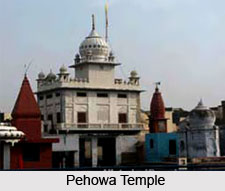Pehowa Temple
|
The Pehowa Temple in the state of Haryana is a place of Hindu pilgrimage.
|
|
|
 The Pehowa Temple situated at Pehowa, 27kms from Thanesar was perhaps built in the 882 AD. But according to an inscription on the temple it was build in the 895 AD. King Mahendrapal was the ruler of Pehowa then. Further excavations put forward the evidences that the town could have been an element of the Mahabharata lore. In ancient time, Pehowa was known as Prithudaka (naming it after King Prithu). The Pehowa Temple situated at Pehowa, 27kms from Thanesar was perhaps built in the 882 AD. But according to an inscription on the temple it was build in the 895 AD. King Mahendrapal was the ruler of Pehowa then. Further excavations put forward the evidences that the town could have been an element of the Mahabharata lore. In ancient time, Pehowa was known as Prithudaka (naming it after King Prithu).
According to a popular legend, King Prithu had a father who lay dying. The dying man had urged Prithu to take him to the river Yamuna so that he could die in peace. The son arranged to move his father to the river and also thought his father to have been cured. But the man died and Prithu felt remorse. He sat on the bank of the river for days on end and made all sorts of offerings to all sorts of gods.
The place where the sad King sat and made the offerings was named Prithudaka Tirth. In honor of the King's sacrifice, many temples and ghats have been built there.
|
|
|
|
 The Pehowa Temple situated at Pehowa, 27kms from Thanesar was perhaps built in the 882 AD. But according to an inscription on the temple it was build in the 895 AD. King Mahendrapal was the ruler of Pehowa then. Further excavations put forward the evidences that the town could have been an element of the Mahabharata lore. In ancient time, Pehowa was known as Prithudaka (naming it after King Prithu).
The Pehowa Temple situated at Pehowa, 27kms from Thanesar was perhaps built in the 882 AD. But according to an inscription on the temple it was build in the 895 AD. King Mahendrapal was the ruler of Pehowa then. Further excavations put forward the evidences that the town could have been an element of the Mahabharata lore. In ancient time, Pehowa was known as Prithudaka (naming it after King Prithu).













